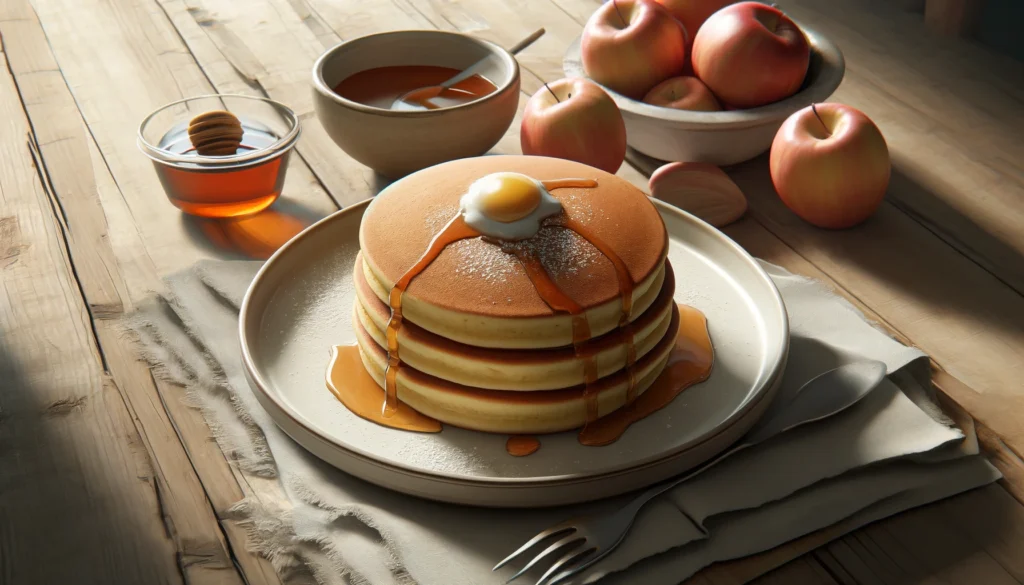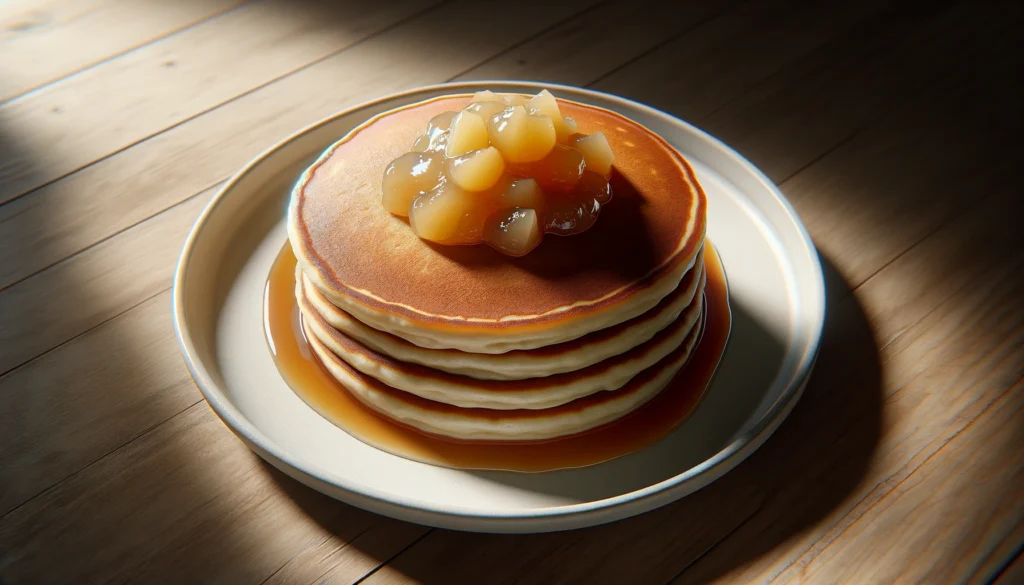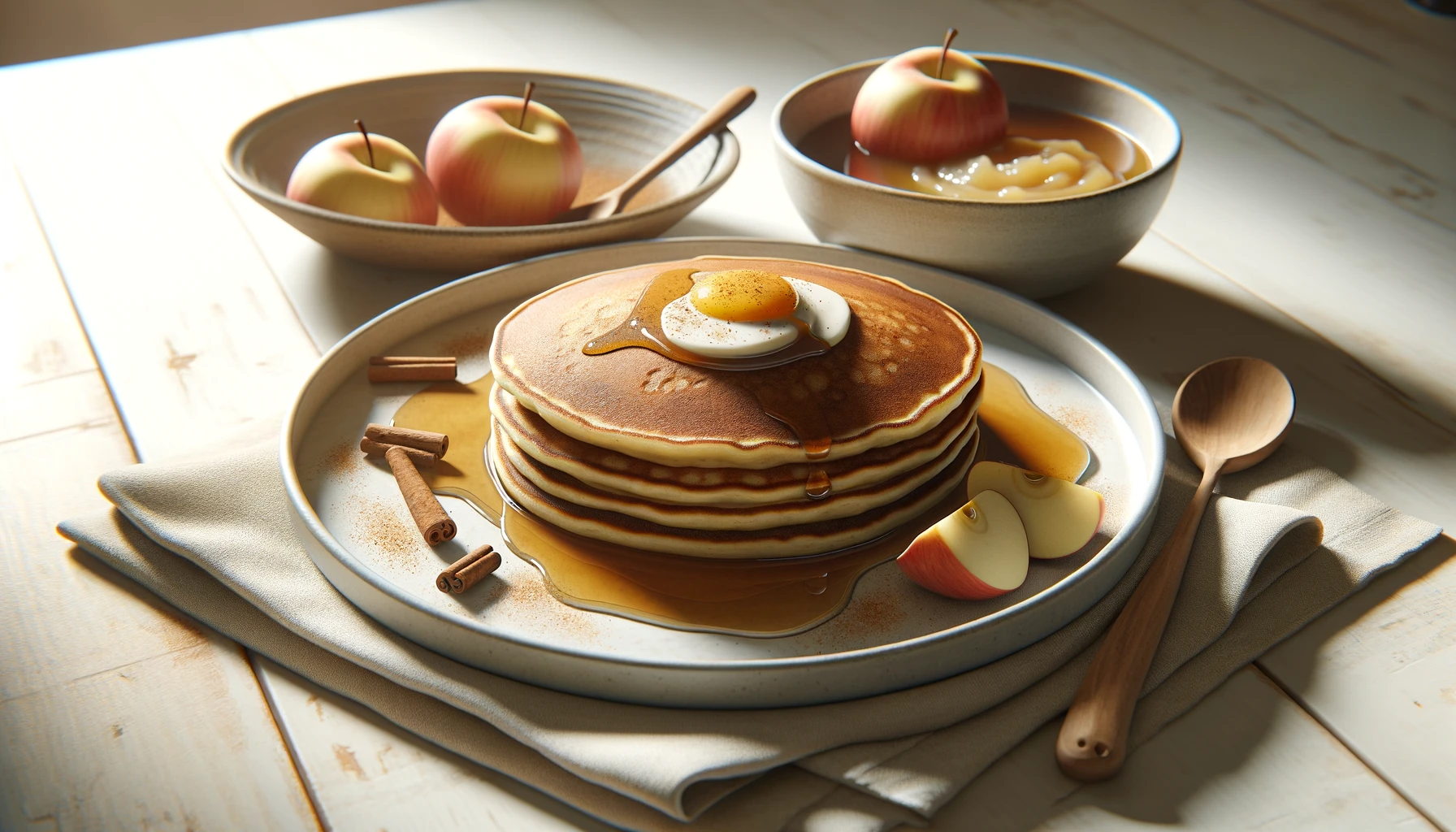Applesauce pancakes without eggs are a delightful variation of the traditional pancake, perfect for those with egg allergies, vegan dietary preferences, or simply looking to experiment with new pancake recipes.
By substituting eggs with applesauce, these pancakes offer a unique flavor profile and a moist texture that sets them apart. This substitution not only simplifies the ingredient list but also enhances the nutritional value by adding natural sweetness and reducing cholesterol content.
Applesauce pancakes are versatile, allowing for a range of toppings and mix-ins, making them a creative and inclusive option for breakfast or brunch. As we explore this recipe, we’ll delve into the benefits of using applesauce instead of eggs and provide a comprehensive overview of the basic ingredients needed to bring these pancakes to your table.
Benefits of Using Applesauce as an Egg Substitute
Applesauce is a fantastic egg substitute in baking due to several benefits. Firstly, it significantly lowers the cholesterol and fat content of dishes, making them heart-healthier. Secondly, applesauce adds moisture to baked goods, which helps in keeping pancakes soft and tender without the use of eggs. This can be particularly appealing for those looking to reduce their intake of animal products or for those with dietary restrictions.
Additionally, applesauce imparts a subtle sweetness and fruity flavor that complements the neutral palette of pancakes, reducing the need for added sugars. It also enhances the nutritional profile by contributing vitamins and fiber. Overall, using applesauce as an egg substitute not only makes recipes healthier but also caters to a wider range of dietary needs while still delivering delicious results.

Basic Ingredients Overview
To make applesauce pancakes without eggs, the recipe revolves around a few staple ingredients that are easily accessible and straightforward to use. The base of the pancake mix typically includes:
- Flour: All-purpose flour is commonly used for its ability to create a light and fluffy texture. However, for those seeking a healthier alternative, whole wheat flour can be used.
- Baking Powder: This acts as the leavening agent that gives the pancakes their rise.
- Salt: A pinch of salt is crucial for balancing the sweetness of the applesauce and enhancing the overall flavor of the pancakes.
- Applesauce: As the star ingredient, unsweetened applesauce replaces eggs and adds moisture and sweetness.
- Milk: Any variety of milk, including dairy or plant-based options like almond, soy, or oat milk, can be used to adjust the batter’s consistency.
- Oil or Butter: A small amount is used to enrich the pancakes and prevent sticking during cooking.
- Sweeteners and Spices: Ingredients such as cinnamon, vanilla extract, or maple syrup can be added to personalize the flavor according to taste.
These ingredients are mixed together to create a smooth batter, which is then cooked on a hot griddle or frying pan until golden brown. The simplicity of the ingredient list and the cooking process makes applesauce pancakes an excellent choice for a quick, nutritious breakfast or a fun cooking activity with kids.
Classic Applesauce Pancakes No Eggs Recipe
Making pancakes without eggs is easier than you might think, and using applesauce as a substitute adds natural sweetness along with a moist texture. This classic applesauce pancake recipe is simple, egg-free, and delicious, perfect for a wholesome breakfast.
Ingredients:
- 1 cup all-purpose flour
- 1 tablespoon sugar
- 2 teaspoons baking powder
- 1/2 teaspoon salt
- 1 cup milk (or dairy-free alternative)
- 1/4 cup unsweetened applesauce
- 2 tablespoons vegetable oil or melted butter
- 1 teaspoon vanilla extract
Instructions:
- Mix Dry Ingredients: In a large bowl, whisk together the flour, sugar, baking powder, and salt.
- Combine Wet Ingredients: In another bowl, mix the milk, applesauce, oil, and vanilla extract until well combined.
- Combine the Mixtures: Add the wet ingredients to the dry ingredients, gently stirring until they’re just mixed. It’s fine if the batter remains somewhat lumpy.
- Heat a Pan or Griddle: Lightly grease a non-stick skillet or griddle and heat it over medium heat.
- Cook Pancakes: Pour 1/4 cup of batter for each pancake onto the hot griddle. Cook until bubbles form on the surface, then flip and cook until golden brown on the other side.
- Serve Warm: Serve the pancakes hot with your favorite syrup or toppings.
Vegan and Gluten-Free Options
To adapt the classic pancakes to be both vegan and gluten-free, make a few simple substitutions to accommodate dietary restrictions without compromising taste or texture.

Ingredients Swap:
- Replace all-purpose flour with a gluten-free flour blend.
- Use a dairy-free milk alternative such as almond, soy, or oat milk.
- Ensure your baking powder is gluten-free.
Vegan Modifications:
- Confirm the sugar is vegan (some sugars are processed with bone char).
- Use a plant-based oil instead of butter for cooking.
Instructions: Follow the same instructions as the classic recipe, but with your substituted ingredients. The result will be delicious pancakes that everyone can enjoy, regardless of dietary preferences.
Creative Flavor Add-ins and Toppings
Transform your pancakes from simple to spectacular with creative add-ins and toppings that add bursts of flavor and texture.
Add-ins:
- Cinnamon & Nutmeg: Add 1/2 teaspoon of cinnamon and a pinch of nutmeg to the batter for a warm spice flavor.
- Fresh Berries: Gently fold 1/2 cup of fresh blueberries or sliced strawberries into the batter for a fruity twist.
- Chocolate Chips: Mix in 1/2 cup of mini chocolate chips for a bit of indulgence.
- Banana & Walnut: Incorporate 1 mashed banana and 1/4 cup chopped walnuts into the batter for a nutty and sweet flavor.
Toppings:
- Maple Syrup and Butter: A classic choice that never goes wrong, enhancing the natural flavors of the pancakes.
- Whipped Coconut Cream: Top with a dollop of whipped coconut cream and a sprinkle of cinnamon for a vegan-friendly treat.
- Apple Compote: Simmer chopped apples with cinnamon and a splash of lemon juice until soft and spoon over pancakes.
- Nut Butter & Honey: Drizzle with almond butter or peanut butter and a little honey for a satisfying, protein-rich topping.
Each option allows you to tailor your pancake experience to suit any taste or occasion, making breakfast an exciting meal to look forward to. Whether you’re going for something simple or extravagant, these variations on applesauce pancakes are sure to impress.
Cooking Techniques and Tips
Step-by-Step Cooking Guide
Cooking can be a delightful experience if you have a clear guide to follow. Here’s a step-by-step guide to making a simple, classic dish: spaghetti carbonara.
- Ingredients Gathering: Start by collecting all your ingredients. For a basic carbonara, you’ll need spaghetti, pancetta or guanciale, eggs, Parmesan cheese, pepper, and salt.
- Preparation of Ingredients: Cut the pancetta into small cubes. Grate the Parmesan cheese finely. Separate the eggs and keep only the yolks (you’ll need about one yolk per person).
- Cooking the Pasta: Bring a large pot of salted water to a boil. Cook the spaghetti according to the package directions until it is al dente. Before draining, set aside a cup of the pasta water for later use.
- Cooking the Pancetta: While the pasta cooks, heat a pan over medium heat and add the pancetta. Cook until it is crispy and the fat is rendered.
- Combining Ingredients: In a mixing bowl, whisk together the egg yolks, Parmesan, and a generous pinch of pepper. Add a little hot pasta water to this mixture to temper the eggs, which prevents them from scrambling when added to the hot pasta.
- Mixing the Pasta: Add the drained pasta to the pan with the pancetta. Remove from heat and quickly pour in the egg mixture, stirring vigorously to coat the pasta without cooking the egg. The residual heat will cook the eggs slightly and create a creamy sauce.
- Final Touches: If the sauce is too thick, add more pasta water a tablespoon at a time. Season with salt and pepper to taste. Serve immediately with extra Parmesan.
Tips for the Perfect Pancake Texture
Achieving the perfect pancake texture—fluffy and light—can elevate a simple breakfast to something extraordinary. Here are some tips:
- Ingredient Temperature: Use ingredients that are at room temperature. Cold milk or eggs can result in a dense pancake.
- Mixing the Batter: Mix the dry and wet ingredients until just combined; lumps are okay! Over-mixing can develop the gluten in the flour, making the pancakes tough.
- Resting the Batter: Let the batter sit for about 30 minutes before cooking. This allows the gluten to relax and the flour to absorb the liquid, helping create a tender texture.
- Consistent Heat: Cook pancakes on a medium heat. Too hot, and they burn before being cooked through; too cool, and they won’t fluff up properly.
Adjusting Batter Consistency
The consistency of your pancake batter can greatly affect the outcome. Here’s how to adjust it:
- Too Thick: If the batter is too thick, it can lead to undercooked centers. Gradually add milk until you reach the desired consistency, which should be similar to a thick but pourable yogurt.
- Too Thin: If the batter is too runny, it can cause the pancakes to spread out too much and become crêpe-like. Thicken the batter by whisking in a small amount of flour until you achieve the right consistency.
These tips and steps should help enhance your cooking skills and enable you to prepare delightful dishes with confidence.
Health Benefits of Key Ingredients
Key ingredients in a balanced meal provide a plethora of health benefits that extend beyond basic nutrition. For instance, whole grains like brown rice and whole wheat are rich in fiber, which aids in digestion and can help maintain a healthy weight by promoting a feeling of fullness. They are also important sources of essential minerals such as magnesium, which is crucial for muscle and nerve function, and selenium, important for immune health.
Vegetables like spinach and broccoli are superfoods loaded with vitamins A, C, and K, along with iron and antioxidants. These nutrients support vision, immune function, and bone health, while the antioxidants help combat free radicals, potentially reducing the risk of chronic diseases like cancer and heart disease.
Proteins such as chicken or legumes not only provide essential amino acids necessary for muscle repair and growth but also contain B vitamins, which are vital for energy production and brain health. Fish, particularly fatty types like salmon, are high in omega-3 fatty acids, which are known to reduce inflammation and are beneficial for heart health.
Healthy fats, like those found in avocados and olive oil, offer vitamin E and monounsaturated fats. These fats are essential for heart health, hormonal balance, and overall cellular function. They also aid in the absorption of fat-soluble vitamins, enhancing the nutritional benefit of other ingredients in the meal.
Caloric and Nutritional Breakdown
A balanced meal typically consists of a mixture of carbohydrates, proteins, and fats in appropriate proportions to support overall health. For instance, a plate containing 30% lean protein, 30% healthy fats, and 40% complex carbohydrates can provide a well-rounded nutritional profile.
A typical meal might include 150 grams of grilled chicken breast, a cup of steamed broccoli, and a half-cup of brown rice. This meal would approximately provide:
- Calories: 350 kcal
- Proteins: 35 grams (high-quality protein from chicken)
- Carbohydrates: 45 grams (primarily from brown rice and broccoli, including dietary fiber for digestive health)
- Fats: 8 grams (mostly unsaturated fats from the chicken and potentially added olive oil)
Such a meal supports sustained energy levels, muscle repair and maintenance, and provides essential vitamins and minerals for overall health. The combination of fiber, protein, and fats also helps in regulating blood sugar levels, making it an excellent choice for weight management and diabetes control.
Storage and Serving Suggestions
Best Practices for Storing and Reheating
Proper storage and reheating are crucial for maintaining the flavor, texture, and safety of food. For most cooked dishes, allow them to cool to room temperature before refrigerating to prevent the growth of bacteria. Store them in airtight containers to retain freshness and prevent absorption of odors from other foods in the refrigerator. It’s advisable to label containers with the date of storage to keep track of their shelf life.
When reheating, ensure the food reaches an internal temperature of at least 165°F (74°C) to kill any harmful bacteria. Use stovetop or oven for best results, as these methods provide more even heating and can restore the texture better than a microwave. For soups and stews, bring them to a boil. If using a microwave, cover the food and stir it midway for even heat distribution.
Serving and Presentation Tips
Presentation enhances the eating experience. Serve meals on warm plates to keep food hot longer. Use garnishes relevant to the dish’s flavors; for example, fresh herbs can add a pop of color and enhance taste. Arrange the components neatly and consider color contrasts for visual appeal. For instance, a sprinkle of paprika can add a vibrant touch to a creamy soup or casserole. Finally, keep portions appropriate and provide serving utensils for dishes meant to be shared. This not only adds a touch of elegance but also ensures that flavors are evenly distributed across the plate.
FAQS:
Can I make these pancakes gluten-free?
Yes, you can easily make gluten-free pancakes by substituting the regular flour with a gluten-free flour blend. Look for a blend that can replace wheat flour at a 1:1 ratio, ensuring it contains xanthan gum or guar gum, which helps mimic the texture and elasticity of gluten. Also, check other ingredients like baking powder to ensure they are gluten-free. Some people like to add a bit of almond flour for extra flavor and nutrition.
How do I make the pancakes fluffier?
To make fluffier pancakes, ensure your baking powder is fresh, as it’s a key leavening agent. You can also separate the egg whites from the yolks, beat them to soft peaks, and gently fold them into the batter to incorporate air. Another tip is to avoid overmixing the batter; just mix until the ingredients are combined. Overmixing can develop the gluten in the flour, resulting in denser pancakes. Lastly, let the batter sit for a few minutes after mixing to allow the baking powder to activate.
What are the best toppings for applesauce pancakes?
Applesauce pancakes pair wonderfully with a variety of toppings. Classic choices include a sprinkle of cinnamon or a dollop of whipped cream to enhance the apple flavor. For a sweet treat, drizzle them with maple syrup or caramel sauce. If you prefer something fruity, top with fresh apple slices, warm sautéed apples, or a berry compote. For a crunchy texture, consider adding chopped nuts like walnuts or pecans.
Can I prepare the batter ahead of time?
Yes, you can prepare pancake batter ahead of time with some adjustments. Mix the dry ingredients and the wet ingredients separately and store them in the fridge. Just before cooking, combine them. This method prevents the activation of the leavening agents (like baking powder) too early. However, for best results, it’s ideal to make the batter and use it within a few hours as the leavening agent will gradually lose its effectiveness.
How long can I store these pancakes?
Cooked pancakes can be stored in the refrigerator for up to 5 days when kept in an airtight container. To extend their shelf life, you can freeze them. Place a piece of parchment paper between each pancake and store them in a freezer-safe bag or container. They can be frozen for up to 2 months. Reheat pancakes in the microwave, toaster, or oven until they are warm and regain their texture.
External links
Here are some links to recipes for eggless applesauce pancakes:
- Vegan Applesauce Pancakes – My Plantiful Cooking
- Cinnamon Applesauce Pancakes – The Simple Veganista
- Vegan Applesauce Pancakes – Elephantastic Vegan
- Applesauce Pancakes (No Flour, Eggs, or Dairy) – The Big Man’s World
- Eggless Apple Cinnamon Pancakes – Safely Delish
These recipes provide a variety of approaches to making delicious pancakes without using eggs, each with a unique twist on incorporating applesauce.

